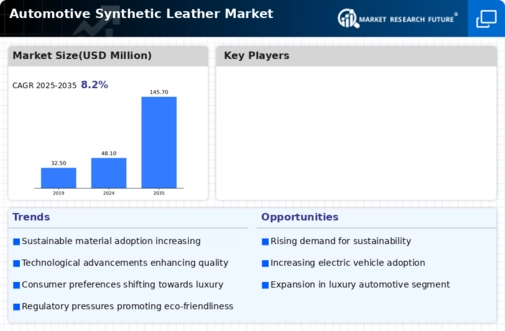Market Share
Automotive Synthetic Leather Market Share Analysis
In the fiercely competitive market of Automotive Synthetic Leather, companies employ various strategies to position themselves effectively and capture significant market share. One of the primary strategies is differentiation, wherein companies aim to set their automotive synthetic leather products apart from competitors by offering unique features, designs, and technological advancements. This may involve innovations in manufacturing processes, creating synthetic leathers that not only mimic the look and feel of genuine leather but also provide additional benefits such as enhanced durability, resistance to wear and tear, and improved environmental sustainability. By emphasizing differentiation, companies attract attention from automotive manufacturers seeking distinctive and high-quality materials, allowing them to carve out a unique market share within the Automotive Synthetic Leather industry.
Cost leadership is another prominent strategy in this market, with companies striving to position themselves as the low-cost providers of Automotive Synthetic Leather. This involves optimizing production processes, sourcing materials efficiently, and managing the supply chain to offer competitive pricing. Cost leadership appeals to cost-conscious automotive manufacturers and can contribute to increased market penetration. However, it's crucial for companies pursuing this strategy to balance cost efficiency with maintaining high-quality standards, aesthetic appeal, and compliance with industry regulations to ensure sustained customer satisfaction and loyalty.
Market segmentation is widely utilized in the Automotive Synthetic Leather industry. Companies analyze the diverse needs of their customer base and develop specialized synthetic leathers tailored for specific market segments. For instance, they might create materials suitable for luxury vehicle interiors, sports cars, or more budget-friendly models. By catering to the unique requirements of each segment, companies establish a robust presence within different automotive markets, contributing to an overall strengthened market share.
Strategic partnerships and collaborations play a pivotal role in the Automotive Synthetic Leather market. Companies often form alliances with automotive manufacturers, interior designers, or suppliers to bolster their distribution networks, enhance brand visibility, and expand market reach. Collaborative efforts can result in shared resources, access to new design trends, and entry into new geographical markets. These strategic partnerships enable companies to navigate industry challenges more effectively, ultimately contributing to a more secure and expanded market share position.
Innovation serves as a fundamental strategy in the Automotive Synthetic Leather market, driven by the continuous pursuit of improved aesthetics, sustainability, and functionality. Companies invest in research and development to introduce synthetic leather formulations with superior properties, such as advanced resistance to wear, eco-friendly materials, and smart features like stain resistance. Innovations in textures, patterns, and color options align with evolving automotive design trends, positioning companies as leaders in the market. By staying at the forefront of innovation, companies not only attract design-conscious automotive manufacturers but also secure a significant market share.
Customer-centric strategies are gaining prominence as companies recognize the importance of delivering exceptional customer experiences. This involves offering customization options, responsive customer support, and collaboration on bespoke design projects. Exceptional customer service contributes to satisfaction and loyalty, encouraging automotive manufacturers to choose a particular brand for their synthetic leather needs. By focusing on building strong relationships with customers, companies can solidify their market share and maintain a competitive edge in the dynamic Automotive Synthetic Leather market.




Leave a Comment